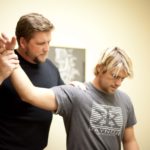 The exact amount is case specific. The doctor will have a better idea after 2 or 3 visits when your body’s response is better understood. Some acute conditions such as a catch sensation in a hip or midback may resolve in one adjustment. Other more chronic subluxations may take 1 to 2 years of treatment to reduce to an optimal level. Some cases will require supportive maintenance the rest of one’s life just at some people need insulin for their diabetes or medication for their heart after bypass surgery.
The exact amount is case specific. The doctor will have a better idea after 2 or 3 visits when your body’s response is better understood. Some acute conditions such as a catch sensation in a hip or midback may resolve in one adjustment. Other more chronic subluxations may take 1 to 2 years of treatment to reduce to an optimal level. Some cases will require supportive maintenance the rest of one’s life just at some people need insulin for their diabetes or medication for their heart after bypass surgery.
Does the Adjustment Hurt
 Typically, no. If one is in so much pain that simply touching the spine hurts, the doctor will apply ice for 15 or 20 minutes and that will reduce the discomfort for the procedure. An adjustment is felt and heard like cracking one’s knuckles. There could be some stretching sensation felt when the lower back or pelvis is adjusted in the side posture position and that is normal.
Typically, no. If one is in so much pain that simply touching the spine hurts, the doctor will apply ice for 15 or 20 minutes and that will reduce the discomfort for the procedure. An adjustment is felt and heard like cracking one’s knuckles. There could be some stretching sensation felt when the lower back or pelvis is adjusted in the side posture position and that is normal.
Can Chiropractic Help Me?
A Few Words On Prevention
I often spend a good deal of time in each patient encounter talking about home care. Part of my reasoning for doing this is to empower my patients with some level of control over their body and the symptoms they experience. In addition I understand that there are things that are effected by quick changes (like the adjustment) and then there are things that only respond to slow sustained forces. When you put these two forms of healing together you can achieve much more than simply employing one or the other.
Regularly my patients find that the out of office recommendations I have made during their recovery are also the best tools for them to use in trying to prevent future occurrences and flare ups.
The purpose of this section of our site is to gradually highlight many of the simple tips and tricks that we give to our patients much like a dentist teaches his or her patients how to properly brush and floss. I hope that the information found here can help visitors to this site learn some simple things, that when made into habits can truly be a source of prevention when it comes to the musculo-skeletal system.
Dr. Johnson
Back Pain Article
The Chiropractic Center is pleased to provide education and information from a variety of trusted, professional resources. Our goal is to increase the knowledge and comfort of our patients across a wide spectrum of interests affecting their health and well being.
If you have specific questions or concerns you’d like to discuss personally with us, please click here . It would be our pleasure to ensure your complete understanding of the science of chiropractic treatments or other subjects covered in the article below.
The Nordic back pain subpopulation program: Can low back pain patterns be predicted from the first consultation with a chiropractor? A longitudinal pilot study.
Alice Kongsted  and Charlotte Leboeuf-Yde
and Charlotte Leboeuf-Yde 
Chiropractic & Osteopathy 2010, 18:8doi:10.1186/1746-1340-18-8
| Published: | 29 April 2010 |
Abstract (provisional)
Background
It is widely believed that non-specific low back pain (LBP) consists of a number of subgroups which should be identified in order to improve treatment effects. In order to identify subgroups, patient characteristics that relate to different outcomes are searched for. However, LBP is often fluctuating or recurring rather than clearly limited in time. Therefore it would be relevant to consider outcome from a longitudinal perspective (describing ‘course patterns’) instead of defining it from an arbitrarily selected end-point after completed treatment.
Aims
The objectives of this pilot study were to investigate the interobserver reliability of a diagnostic classification system and to evaluate whether diagnostic classes or other baseline characteristics are associated with the LBP course pattern over a period of 18 weeks.
Methods
Patients visiting one of 7 chiropractors because of LBP were classified according to a diagnostic classification system, which includes end-range loading, SI-joint pain provocation tests, neurological examination and tests for muscle tenderness and abnormal nerve tension. In addition, age, gender, duration of pain and presence of leg pain were registered in the patient’s file. By weekly SMS-messages on their mobile phones, patients were asked how many days they had LBP the preceding week, and these answers were transformed into pain course patterns and the total number of LBP days.
Results
A total of 110 patients were included and 76 (69 %) completed follow-up. Thirty-five patients were examined by two chiropractors. The agreement regarding diagnostic classes was 83% (95 % CI: 70 – 96). The diagnostic classes were associated with the pain course patterns and number of LBP days. Patients with disc pain had the highest number of LBP days and patients with muscular pain reported the fewest (35 vs. 12 days, p<0.01). Men had better outcome than women (17 vs. 29 days, p < 0.01) and patients without leg pain tended to have fewer LBP days than those with leg pain (21 vs.31 days, p=0.06). Duration of LBP at the first visit was not associated with outcome.
Conclusions
The study indicated that there is a clinically meaningful relationship between diagnostic classes and the course of LBP. This should be evaluated in more depth.






